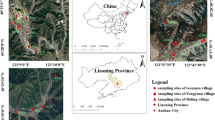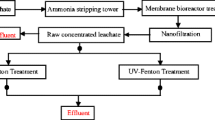Abstract
Landfill leachates contain a large amount of unknown harmful compounds derived from domestic and industrial sources. A toxicity effect-directed approach was used to identify biologically active compounds in three landfill leachate samples (S1–S3) by combining the Microtox test with reverse-phase high performance liquid chromatography (RP-HPLC) fractionation and gas chromatography/mass spectrometry (GC/MS) analysis. Organic toxicants were recovered from coarse fractions only in S1 and in S2. Fine fractionation exhibited a somewhat different toxicity pattern in S1 and S2. GC/MS analysis positively identified Bisphenol A (BPA) and 4-t-butylphenol (4-t-BP) in both samples, N-ethyltoluenesulfoneamide (NETSA) was detected only in S1. However, their concentrations were not high enough to be responsible for the observed toxicity in original samples. A synergistic effect among detected organic compounds (BPA, NETSA, and 4-t-BP) was demonstrated. Each compound present at 1/7 of its individual EC50, might lead to undesirable mixture toxicity, which indicated that interactive effects may, to a certain extent, play a role in landfill leachates with complex matrices. The results from further hydrophobicity analysis and estrogen receptor (ER) competitive binding assays of fraction 13 of both samples gave evidence that some possible toxicants that failed to be identified by GC/MS might be endocrine disrupting chemical(s) (EDC) with a log K ow range of 3.5–3.7 in both samples.




Similar content being viewed by others
References
Agenson KO, Oh J-Ik, Urase T (2003) Retention of a wide variety of organic pollutants by different nanofiltration/reverse osmosis membranes: controlling parameter of process. J Membr Sci 225:91–103
Alexander HC, Dill DC, Smith LA, Guiney PA, Dorn PB (1988) Bisphenol A: acute aquatic toxicity. Environ Toxicol Chem 7:19–26
Bedient PB, Rifai HS, Newell CJ (1994) Ground water contamination: transport and remediation. PTR Prentice Hall, Englewood Cliffs, NJ
Brack W, Schirmer K (2003) Effect-directed identification of oxygen and sulfur heterocycles as major polycyclic aromatic cytochrome P4501A-inducers in a contaminated sediment. Environ Sci Technol 37:3062–3070
Corporation Microbics (1992) Microtox manual: a toxicity testing handbook. Microbics Corporation, Carlsbad, CA
Durhan EJ, Norberg-King TJ, Burkhard LP (1993) Methods for aquatic toxicity identification evaluations: phase II toxicity identification procedures for samples exhibiting acute and chronic toxicity EPA/600/R-92/080. U.S. Environmental Protection Agency, Duluth, MN, USA
Farré M, Barceló D (2003) Toxicity testing of wastewater and sewage sludge by biosensors, bioassays and chemical analysis. Trends Anal Chem 22:299–310
Fernandez N, Beiras R (2001) Combined toxicity of dissolved mercury with copper, lead and cadmium on embryogenesis and early larval growth of the Paracentrotus lividus sea-urchin. Ecotoxicology 10:263–271
Galassi S, Benfenati E (2000) Fractionation and toxicity evaluation of waste waters. J Chromatogr A 889:149–154
Hernandoa MD, Ejerhoona M, Fernandez-Albaa AR, Chistib Y (2003) Combined toxicity effects of MTBE and pesticides measured with Vibrio fischeri and Daphnia magna bioassays. Water Res 37:4091–4098
ISO 11348-3 (2007) Water quality—determination of the inhibitory effect of water samples on the light emission of Vibrio Fischeri (Luminescent Bacteria Test)—part 3: method using freeze-dried bacteria. International Organization for Standardization, Geneva
Kawagoshi Y, Fujita Y, Kishi I, Fukunaga I (2003) Estrogenic chemicals and estrogenic activity in leachate from municipal waste landfill determined by yeast two-hybrid assay. J Environ Monit 5:269–274
Könemann H (1981) Fish toxicity tests with mixtures of more than two chemicals: a proposal for a quantitative approach and experimental results. Toxicology 19(3):229–238
Lei L, Piao M, Nishizaki H, Nakamura H, Aoyama I (2006) Toxicity identification evaluation on industrial and municipal solid waste landfill leachates. Jpn J Environ Toxicol 9:11–21
Nishihara T, Nishikawa J, Kanayama T, Dakeyama F, Saito K, Imagawa M, Takatori S, Kitagawa Y, Hori S, Utsumi H (2000) Estrogenic activities of 517 chemicals by yeast two-hybrid assay. J Health Sci 46:282–298
Oman C, Hynning PA (1993) Identification of organic compounds in municipal landfill leachates. Environ Pollut 80:265–271
Reemtsma T (2001) Prospects of toxicity-directed wastewater analysis. Anal Chim Acta 426:279–287
Reemtsma T, Putschew A, Jekel M (1999) Industrial wastewater analysis: a toxicity-directed approach. Waste Manag 19:181–188
Ren S (2004) Assessing wastewater toxicity to activated sludge: recent research and developments. Environ Int 30:1151–1164
Simmons JE, Berman E (1989) Toxicity of complex waste mixtures: a comparison of observed and predicted lethality. J Toxicol Environ Health 27:275–286
Sprague JB, Ramsay BA (1965) Lethal levels of mixed copper-zinc solutions for juvenile salmon. J Fish Res Board Can 22:425–432
Staples CA, Dorn PB, Klecka GM, Oblock ST, Harris LR (1998) A review of the environmental fate, effects and exposures of bisphenol A. Chemosphere 36:2149–2173
Svenson A, Norin H, Hynning PA (1996) Toxicity-directed fractionation of effluents using the bioluminescence of Vibrio fischeri and gas chromatography/mass spectroscopy identification of the toxic components. Environ Toxicol Water Qual 11:277–284
Yasuhara A, Shiraishi H, Nishikawa M, Yamamoto T, Uehiro T, Nakasugi O, Okumura T, Kenmotsu K, Fukui H, Nagase M, Ono Y, Kawagoshi Y, Baba K, Noma Y (1997) Determination of organic components in leachates from hazardous waste disposal sites in Japan by gas chromatography/mass spectrometry. J Chromatogr A 774:321–332
Yasuhara A, Shiraishi H, Nishikawa M, Yamamoto T, Nakasugi O, Okumura T, Kenmotsu K, Fukui H, Nagase M, Kawagoshi Y (1999) Organic components in leachates from hazardous waste disposal sites. Waste Manag Res 17:186–197
Acknowledgements
This work was jointly supported by “21st Century COE Program of Education Ministry of Japan: Strategic Solid Waste Management for a Sustainable Society” and by “The Scientific Research Foundation for the Returned Overseas Chinese Scholars, State Education Ministry”.
Author information
Authors and Affiliations
Corresponding author
Rights and permissions
About this article
Cite this article
Lei, L., Aoyama, I. Effect-directed investigation and interactive effect of organic toxicants in landfill leachates combining Microtox test with RP-HPLC fractionation and GC/MS analysis. Ecotoxicology 19, 1268–1276 (2010). https://doi.org/10.1007/s10646-010-0511-2
Accepted:
Published:
Issue Date:
DOI: https://doi.org/10.1007/s10646-010-0511-2




